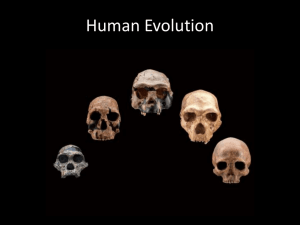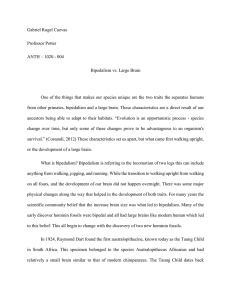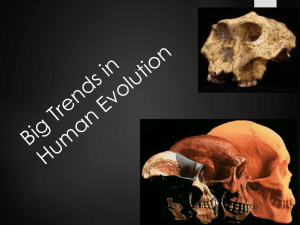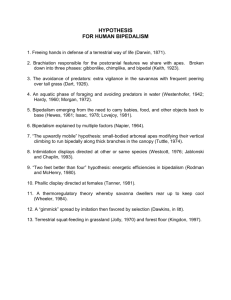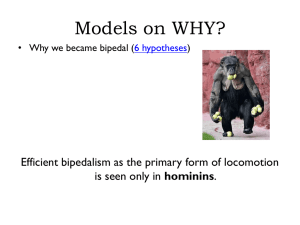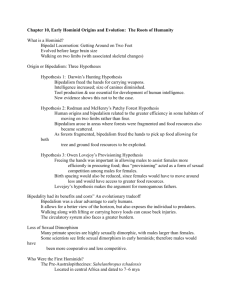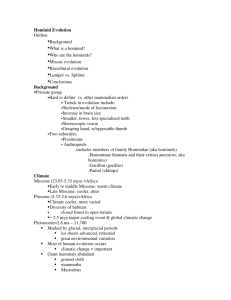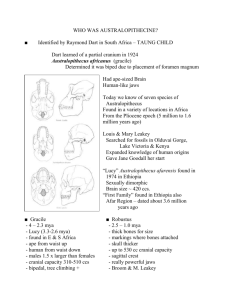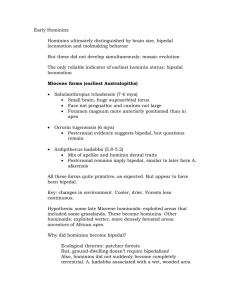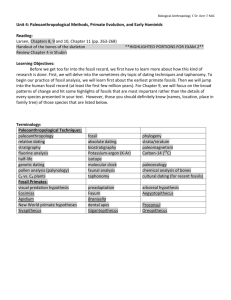Early hominid origins and evolution: the roots of humanity
advertisement
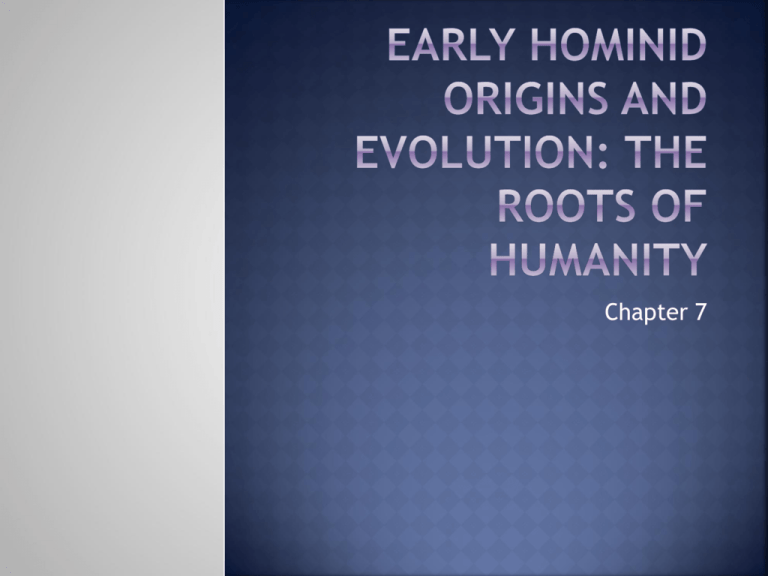
Chapter 7 Charles Dawson found a fossil that he said was the “missing link” It had a human skull and an ape jaw Called Piltdown Man It was a hoax (human skull fused with an orangutan jaw) Shows people (wrongly) thought human ancestors were hybrid ape-men It is not big brains It is bipedalism We began walking bipedally 7 mya (million years ago) We got big brains only 2 mya Please remember: Hominids are ancestors of any apes Hominins are ancestors of humans Historically, scientists believed the identifiable feature of human ancestors was big brains This was not supported in the fossil record How would we tell bipedalism from a fossil? Also remember that humans go in the ape classification of Hominoid Why? Also remember that humans go in the ape classification of Hominoid Why? Y-5 molar No tail Shared DNA 1. foramen magnum underneath skull 2. short, wide pelvis 3. long legs 4. no opposable big toe 5. double-curved spine Honing canine: apes’ canines cut and shred food and are large and dangerous and they have a diastema. Humans have small, nonhoning canines and no diastema Apes have powerful chewing muscles and a sagittal crest for extra power. Humans are weak chewers Why? What invention did human ancestors have that made food processing easier? It is hypothesized that our ancestors were knuckle-walkers, which allowed for easier upright standing Climate and environmental changes may have selected for bipedalism Darwin’s Hunting Hypothesis: because of similarities between humans and apes, he concluded Africa must be our origin. There must have been something to shift us to walking on the ground Unique human traits: Bipedal vs quadrupedal Tiny canines vs large canines Tool use vs no tool use Big brains vs smaller brains Darwin’s Hunting Hypothesis: Darwin asked what advantages bipedalism had and he concluded it freed the hands for holding weapons We now know that we walked many millions of years before tools were made, but his hypothesis laid the foundation Another hypothesis involved the forest becoming fragmented, and hominids walking on two legs in between patches of trees. Used less energy Could see predators Could hold things with hands Less of the body in direct sunlight Owen Lovejoy’s Provisioning Hypothesis: heavy parental investment by mothers led to bipedalism Males would better provision females if bipedal (free hands to carry more food) Better infant survival and higher fitness for mother Small level of sexual dimorphism in fossils supports this (cooperation of male and female pair…not males fighting for one female) Pros: Can carry things (frees hands) Can see predators Can save energy Cons: We are slow If carrying items, makes us easy targets Back injuries If injure a foot, very difficult to get around Pre-Australopithecines Australopithecines Paranthropus Rift Valley Volcanic rock What dating technique? Sahelanthropus tchadensis: earliest ancestor/oldest biped “Chad Man” 7-6 mya Central Africa (Chad) Small brain (350 cubic cm, cc) Bipedal (foramen magnum) Nonhoning canine Close to the divergence of human line from ape line Sahelanthropus tchadensis Orrorin tugenensis: “Original Man” 6 mya Mostly femurs (thigh bone) Show bipedalism Nonhoning canines Aridpithecus ramidus: “Great-grandma” “Ardi” 4-6 mya Bipedal All species so far still spent time in the trees…why? May be direct ancestor to Australopithecines Aridpithecus ramidus: Australopithecines: Hundreds of fossils from at least 7 species Not 100% sure of all the relationships Australopithecus africanus: Raymond Dart found a small skull in a cave “Taung Baby” 4-3 mya Thought baby ape at 1st Small teeth, bidpedal foramen magnum Later adult fossils had small canines too *Showed that bipedalism came way before big brains* Australopithecus africanus: Australopithecus afarensis: Kenya and ethiopia 3 mya Best-known and best-represented “Lucy” over 40% of skeleton (but over 80% because skeleton is symmetrical) If Ardi is great-grandma, Lucy is grandma Foramen magnum, pelvis, legs, and feet all bipedal Curved fingers (why?) Small brain still (430 cc) Australopithecus Smaller afarensis: canines Laetoli Prints: fossilized footprints in volcanic ash (how would you date these??) Showed bipedalism and ‘first family’ (2 adults, 1 child) Australopithecus afarensis: Australopithecus: Beginning 3mya, two lines of hominin evolution occurred, each with unique adaptations One line went extinct and one line led to genus Homo This next group is the second line that went extinct Some still call this group “robust” Australopithecus but there are enough differences that I split them into a new genus Paranthropus Paranthropus: 2.5 mya Larger, more robust bodies but small brains Sagittal crest Huge molars for crushing tough food Flaring face Do we have these adaptations? Specialized food source may have led to extinction Paranthropus: AUSTRALOPITHECUS Biped Slender Small brain Rounder head Smaller teeth Varied diet PARANTHROPUS Biped Robust Small brain (smaller than A.) Flared head Sagittal crest Large molars Specializeed, tough diet
